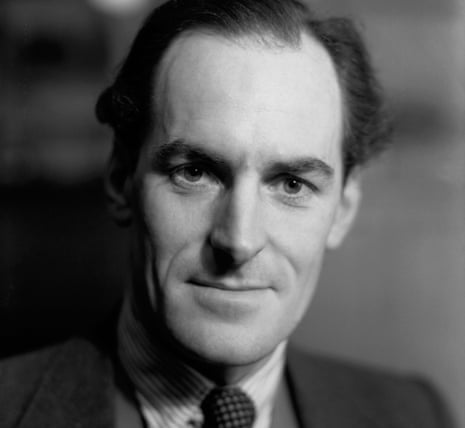The novelist Ian Fleming and the typographer Robert Harling became close and confessional friends during their service with naval intelligence in the second world war, and this week Harling’s account of their long friendship has eventually been published, seven years after the author’s death at the age of 98.
I went to the launch party in a Holland Park bookshop and there met a woman, a newspaper colleague of Harling’s and mine 40 years ago, who remembered asking him if he were the model for James Bond. “Oh, Fleming and I got up to a few pranks together,” was Harling’s gnomic reply, not entirely discounting the possibility. Of course, Bond has as many prototypes as Elvis has lookalikes, and in any case Harling appears more recognisably in The Spy Who Loved Me as the knowledgable printer who knows obscure typefaces. Then again, Harling’s entry in the Dictionary of National Biography rings true when it says that he and Bond shared a “sardonic elegance of manner and cool sexual expertise”.
I knew him a little. His attitude to women is difficult to separate from his attitude to sex, in which he showed a lusty, frank and constant interest. His conversation wouldn’t be possible in an office now. Even in 1970 it was unusual; you noticed him for it. Reading his book this week, I saw a few of his favourite words and remembered how quaint and slightly camp his language could be. “My glossy” was how he referred to House and Garden, the magazine he edited. “That’s a nice little numero,” he might say appraisingly of a new secretary. “Meeting a popsy?” was a typical question if he met you going down in the lift. The style came out of wardrooms and airfields, but Harling gave it a twist of the West End. His clothes, too, were slightly theatrical. He was a sprightly man, not tall, with a touch of the dancer in him. He wore a black fedora over silvery hair, thin on top and curling at the sides, and trousers that were astonishingly tight. “I don’t know how you make quick getaways in trousers like those,” his friend Lucian Freud is alleged to have said, bearing angry cuckolds in mind.
As well as editing House and Garden, he came into the Sunday Times every Friday and Saturday to design the paper’s news pages. This was a peculiar and luxurious arrangement – all other pages went through the regular design department – and it dated from 1945, when the Sunday Times’s then owner, Lord Kemsley, had hired him as his typographical consultant. Fleming, also newly demobbed, had been hired around the same time as the paper’s foreign manager. A friendship established in the war, when Fleming had recruited Harling from his convoy duties to more esoteric intelligence work, was now sustained by lunches at smart restaurants at which – by Harling’s account – the Bond creator talked about his dark sadomasochistic needs.
None of us who worked with Harling at the paper knew much about this history. He talked very little about himself. He’d come into the office with his sharpened pencils and draw the dummy pages that the men in the composing room would translate into hot metal. Several people occasionally did this work, including me, but Harling turned it into an art, not just indicating, say, the position and dimensions of a photograph but also roughly reproducing it as a drawing. He stood against a tilted board as he drew, negligently shading the shape of a tree or a head. None of this was necessary – position and dimensions were all that the compositor needed – but Harling liked to draw.
Some facts did emerge. He had written a novel, The Paper Palace, a thriller set in Fleet Street, published in 1951. After I found and read a secondhand copy, I told him how much I’d enjoyed it. He smiled and said that at the time he’d been compared to Robert Penn Warren, the American who wrote the Pulitzer-winning All the King’s Men, but he said it, like he said most things, as if it wasn’t to be taken at all seriously. In fact, he’d published seven novels and other books besides – two of them true (or true-ish?) accounts of his sailing days, including his time spent at Dunkirk and in the heaving North Atlantic on the bridge of a corvette. But he kept these things to himself. When Don Berry, then the editor in charge of the news pages, asked him what he’d done in the war, he said, “Oh, I visited a lot of nice places and drew some nice pictures.” That can be read now as a euphemism for the intelligence gathering he did for the group known as “Fleming’s secret army”, but then as now, it seemed wilfully mysterious.
He invited me a few times for Sunday lunch at his beautiful house, an 18th-century vicarage in the Strawberry Hill gothic style on the southern edge of the North Downs. Its walls were crowded with pictures by English artists and illustrators such as Eric Ravilious and Edward Bawden, whom Harling had commissioned in his prewar career as a young but influential designer and typographer. His books on decoration and his typefaces – Playbill, Chisel and Tea Chest are the famous ones – created a jollier version of the Victorian age and helped shape the postwar fashion for Victoriana. Not that he said any of this, and not that I understood it till long after.
His part-time job at the Sunday Times lasted for 40 years. A secret little party was planned for his last day – secret because his colleagues knew that he wasn’t naturally gregarious. Around 6pm, after the first edition had gone to press, Berry led him on a pretext to the editor’s office, where a few senior people had gathered. Champagne popped; the editor, Frank Giles, made a warm speech; there was applause. Harling replied in a sentence: “I’ve always thought these occasions nauseating and this has been no exception.” Then he walked out of the building and was never seen in it again.
In the new book, his 25-year relationship with Fleming is mainly presented in the form of dialogue, very similar to the kind found in his novels: slightly terse and knowing, and rather hard-boiled – and, of course, largely invented, for which of us can remember what was said yesterday at lunch, never mind 40 years ago at the Etoile?
In the to-and-fro, Fleming comes across as troubled and complicated – someone who enjoys a good whipping and is killing himself with tobacco and drink, and therefore a contrast to his friend, the narrator, who is happily married and for whom promiscuity and adultery are moralistic words for straightforward appetites.
In life, rather than in a book trying to be life-like, the facts tend to reverse this contrast. After Harling died in 2008, his obituaries accepted his version of his early life: that, following the death of both his parents, Harling had been taken from London to Brighton as a three-year-old and raised at the seaside by a relative and her dairyman husband. Later research showed this was complete invention. He grew up and went to school in Islington, with a living mother and a father who drove a London taxi. He had a brother and a first wife who, like his parents, had been ruthlessly excised by Harling from his biography, and came as a revelation to his middle-aged children.
Fleming’s complications were open to view. Harling’s were closed and unknowable. He would have found our surprise amusing.

